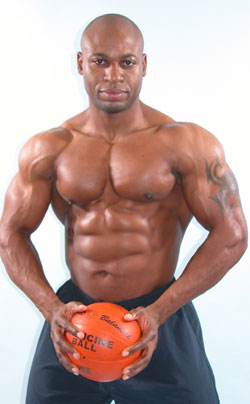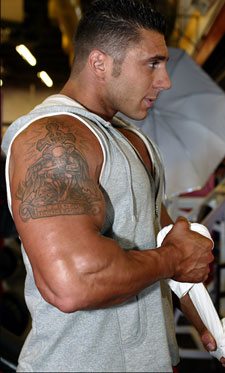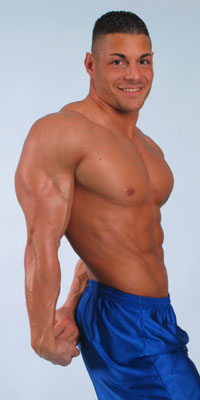|
Partial Training For Full-Powered Results
 Have you ever thought to yourself "I wish I didnít have to do the whole rep even though I know Iím supposed to?"
Have you ever thought to yourself "I wish I didnít have to do the whole rep even though I know Iím supposed to?"
Well, guess what? You donít!
Not only are partial-range reps perfectly "legal," they can be far more effective than full-range reps for building serious strength as quickly as possible. Partial range reps, which I will refer to as "partials" from now on, are basically reps done in a specific range of motion. A partial bench press, for example, may involve doing only the top six inches of the range of motion. Partial reps have one major advantage over full range reps: you can target your resistance to the specific range of motion you are working in.
Think of the bench press again. You know how much easier the weight feels after you get past the sticking point. Obviously, that sticking point is limiting the amount of weight you are able to use on the exercise.If you are only able to get 200 pounds past the sticking point, but your chest muscles are capable of handling 300 pounds once youíre past it, you will be limiting your ultimate muscle mass and strength levels by only using 200 pounds.
This is where partial training comes in. By working only in the range of motion ABOVE the sticking point, you can use far more weight and, therefore, work your muscles at a far higher threshold. By working at a higher weight, you will not only be getting your muscles used to handling those heavier weights, you will be building your connective tissue to help handle those loads.
From personal experience, I know how dramatic the effect training the connective tissue to handle heavier loads can be. For years, I was stuck a maximum of 300 pounds on the flat bench press. No matter how hard I worked, nothing seemed to help. Then I discovered partials.
By working partials consistently, I brought my max bench press up to 350 pounds in a matter of months. It made me realize that my connective tissue strength was holding me back, not my muscle strength, and nothing builds connective tissue better than extremely heavy weights.
To give you an idea of the kind of weight your body may be capable of moving with partials, while at a bodyweight of approximately 210 pounds, Iíve done top range partial bench presses with 750 pounds and top range partial squats with 1100 pounds. Partials with this extremely heavy weight builds up incredible connective tissue strength and helps you build strength extremely quickly.
Partials are useful not only in the ranges of motion where you can use the heaviest weights, but in the ranges of motion where you are at your weakest. Using the barbell squat for an example, think of where the weakest point in the range of motion would be. The very bottom, right?
Now imagine setting up a barbell in the power rack at the very bottom position of the squat. You get under the bar, then, starting from a dead stop, you squat the weight up a few inches then lower it back down to the safey rails.
All of the stress of the exercise is placed on your muscles in their least favorable leverage, which will build up your weakest point. This can dramatically increase your strength and power in that weak range, which can have a dramatic effect on how much weight you'll be able to use for full range reps.
 Partial training concepts can be applied to almost any exercise you can imagine, however partials are certainly more appropriate for some exercises than others. This is especially true of exercises that already have a short range of motion or need a full range of motion to be effective.
Partial training concepts can be applied to almost any exercise you can imagine, however partials are certainly more appropriate for some exercises than others. This is especially true of exercises that already have a short range of motion or need a full range of motion to be effective.
Some exercises partials work very well for include: bench press (a barbell is much better than dumbells as you can use the power rack rails to easily adjust your range of motion), squats, deadlifts, barbell and dumbell curls, barbell shoulder press, dips, close grip bench, pushdowns, bent-over rows, and calf raises.
There are several very important things to note about partial training:
1. You should keep some full range movements in your program. Donít do partial movements exclusively for too long. I would recommend alternating sessions of partial and full-range training.
2. Training with extremely heavy weights is extremely demanding on the body. You may find you need more time to recover from partial training sessions than regular training sessions.
3. Because this training strongly affects the connective tissue, itís a good idea to supplement with nutrients that support the joints. These include Vitamin C (helps support collagen formation), calcium, glucosamine and chondroitin, MSM, and gelatin. These nutrients will help your body to recover faster from this heavy training.
4. Heavy partial training should not be done long term. I normally limit partial training to 6 weeks at a time, returning to full-range training for awhile. Taking time off partials not only allows your body time to recover from the extremely heavy weights but gives you a chance to put your newfound connective tissue strength to work in full-range training.
Partial Pointers
Describing how to do partials for every exercise I mentioned previously is beyond the scope of this article, but here are some pointers that will help you use partials in your workouts.
1. The power rack is your best friend. By setting the heights of the safety rails appropriately, you can stop the barbell at nearly any point in the range of motion of almost any barbell exercise.
2. Before you do a heavy partial rep, be sure to prepare yourself. Tighten up your muscles and prepare mentally. Partials are very different than full reps because of the far greater weights youíll be able to use.
3. Set aside your preconceptions of how much weight youíre capable of lifting. You really will be amazed by how much more you can lift when you only work in your strongest range of motion.
 4. Donít forget about working in your weakest ranges of motion too. It may not be as glamorous but working the weak range is very important for building up maximum full-range strength.
4. Donít forget about working in your weakest ranges of motion too. It may not be as glamorous but working the weak range is very important for building up maximum full-range strength.
5. Work your poundages up gradually but donít be afraid to push yourself. Just because you can lift a ton more immediately doesnít necessarily mean you should. For the first few sessions, only go about 10 to 20% over your full range one-rep max. You need to give your body a chance to adapt to this totally different type of stress.
Your progress should be steady after that. Increases of up to 50 pounds or more per session are not uncommon on some of the larger muscle exercises such as bench press or squats. Try to move your poundages up each session, even if itís only by 5, 10, or 20 pounds.
6. Have fun!! Youíll relish the incredulous looks you get from other people when you get to the point where you can lie down under a bar loaded with 7 plates on either side. You may have to apologize to others for using all the weight plates though!
To sum it up, partials are an extremely valuable training technique. They can help you blast through strength plateaus by building up not only your muscles and connective tissue, but your confidence with very heavy weights as well.

More Articles by Author Nick Nilsson
Return To Weight Lifting Articles Archive
|